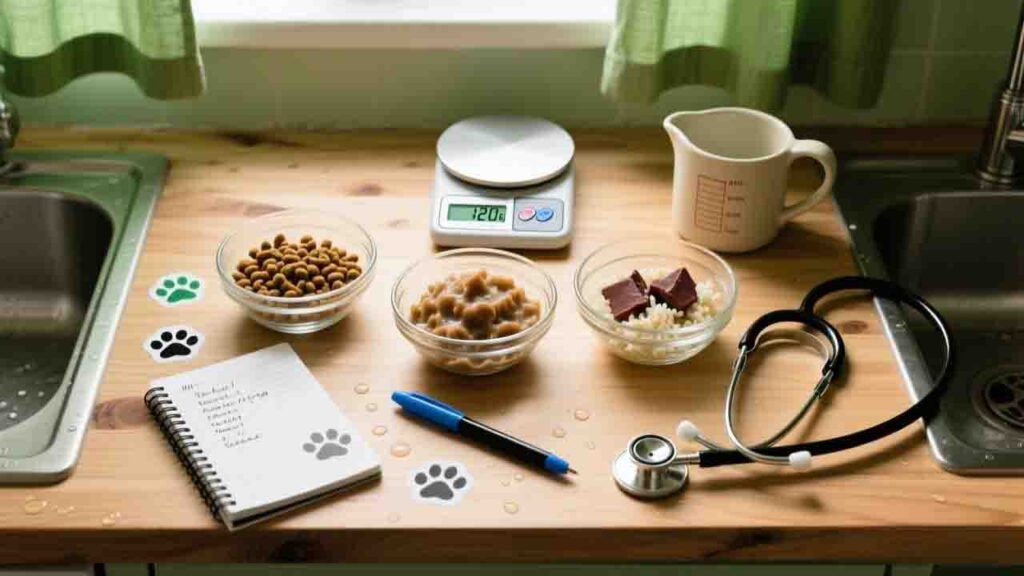Table of Contents
-
Understanding the Pet Digestive System
1. Understanding the Pet Digestive System
More Than Just a Stomach: A Complex Processing Plant
The pet digestive system represents a sophisticated biological processing system that transforms food into essential nutrients while serving as the body’s first line of immunological defense. This complex tract extends from the mouth to the colon, with each component playing a vital role in maintaining overall health. For UK pet owners, understanding this system is crucial for recognising early warning signs of potential health issues before they become serious problems.
The digestive system functions as both a nutritional converter and a waste management facility, ensuring optimal nutrient absorption while safely eliminating toxins and byproducts. Its proper function directly impacts everything from your pet’s energy levels to their immune response and coat condition.
Core Components and Their Functions
-
Oral Cavity: Mechanical breakdown through chewing and enzymatic initiation of carbohydrate digestion
-
Esophagus: Muscular transportation tube delivering food to the stomach
-
Stomach: Acidic environment for protein denaturation and pathogen control
-
Small Intestine: Primary site of nutrient absorption with villi and microvilli increasing surface area
-
Large Intestine: Water reabsorption and fermentation of fibrous materials
-
Accessory Organs: Liver, gallbladder, and pancreas contributing digestive enzymes and bile
Q: How quickly does food typically pass through my pet’s digestive system?
A: The transit time varies by species, size, and diet, but generally takes 8-12 hours for dogs and 12-24 hours for cats. This is significantly faster than the human digestive process, which typically takes 30-40 hours, explaining why digestive issues often manifest more rapidly in pets.
2. The Science of Canine and Feline Digestion
The Biochemical Processes of Nutrient Extraction
Digestion involves a sophisticated series of enzymatic reactions and mechanical processes that systematically break down complex food molecules into absorbable components. Proteins undergo hydrolysis into amino acids, carbohydrates reduce to simple sugars, and fats emulsify into fatty acids and glycerol—all through precisely coordinated biological mechanisms.
The gut microbiome—comprising trillions of bacteria, fungi, and other microorganisms—plays an equally crucial role in this process. These microbial communities not only aid in fermenting indigestible fibers but also produce essential vitamins and fatty acids while training the immune system to distinguish between pathogens and harmless antigens.

Species-Specific Digestive Variations
Understanding the fundamental differences between canine and feline digestion explains why their dietary requirements differ significantly:
Canine Digestive Adaptations
-
Moderate small intestine length relative to body size (approximately 4 times body length)
-
Capacity for both mechanical and chemical breakdown of plant materials
-
Limited ability to produce endogenous enzymes for cellulose digestion
-
Robust gastric acidity (pH 1-2 when fasting) providing strong pathogen defense
Feline Digestive Specializations
-
Shorter digestive tract relative to body size (approximately 3 times body length)
-
Higher protein requirement with essential need for amino acids like taurine
-
Limited hepatic enzyme activity for processing plant-based materials
-
Reduced ability to convert beta-carotene to vitamin A compared to dogs
Q: Why are some human foods dangerous for pets when they seem similar to pet food?
A: Beyond the obvious toxins like chocolate and grapes, pets have different metabolic pathways and nutritional requirements. For instance, cats cannot synthesize sufficient taurine, while dogs have limited ability to process theobromine. These species-specific biochemical differences explain why specially formulated diets are essential for optimal health.
3. Identifying Digestive Issues: A Step-by-Step Guide
The Clinical Observation Framework
Systematic observation allows early detection of digestive disturbances before they escalate into serious health concerns. Implement this structured approach when monitoring your pet’s gastrointestinal health:
Phase 1: Baseline Establishment
-
Document normal bowel movement frequency, consistency, and color for 2-3 weeks
-
Establish individual hydration benchmarks by measuring water consumption
-
Record typical appetite patterns and food motivations
-
Note energy fluctuations throughout the day and after meals
Phase 2: Symptom Identification and Categorization
Categorize observations to help your veterinarian narrow potential causes:
Upper GI Indicators (Stomach and Small Intestine)
-
Vomiting: Active expulsion of stomach contents, often preceded by nausea
-
Regurgitation: Passive expulsion of undigested food from the esophagus
-
Bilious Vomiting: Yellow-tinged stomach secretions indicating empty stomach irritation
-
Excessive Grass Consumption: Potential attempt to alleviate gastric discomfort
Lower GI Indicators (Colon and Large Intestine)
-
Diarrhea: Loose, unformed stools with increased water content
-
Mucus Presence: Jelly-like substance indicating colon irritation
-
Tenesmus: Straining without productive defecation
-
Increased Frequency: More frequent small-volume bowel movements
Phase 3: Pattern Recognition and Documentation
-
Track symptom timing relative to meals, activities, and environmental changes
-
Document progression and changes in symptom severity
-
Note accompanying signs like lethargy, behavior changes, or appetite shifts
-
Photograph concerning stools or vomitus for veterinary reference
The Bristol Stool Chart Adaptation for Pets
While no formal standardized chart exists for pets, owners can modify the human Bristol Stool Chart concept:
Type 1-2: Hard, dry pellets suggesting dehydration or constipation
Type 3-4: Well-formed, moist logs representing ideal consistency
Type 5-7: Soft, loose, or watery indicating various digestive disturbances
Q: When should I be genuinely concerned about my pet’s digestive symptoms?
A: Seek veterinary attention immediately for symptoms including blood in vomit or stool, projectile vomiting, distended abdomen, non-productive retching, symptoms lasting over 48 hours, or when accompanied by lethargy, pain, or significant behavior changes. These red flags may indicate serious conditions requiring prompt medical intervention.
4. Implementing a Digestive Care Plan
The Veterinary Partnership Model
Before implementing any digestive care plan, establish a collaborative relationship with your veterinary practice. Their expertise ensures appropriate diagnosis and tailored recommendations based on your pet’s specific needs, age, breed predispositions, and health history.
The Four-Phase Digestive Rehabilitation Protocol
Phase 1: Veterinary Assessment and Diagnostic Testing
-
Comprehensive physical examination including abdominal palpation
-
Fecal analysis for parasites, bacteria, and digestive efficiency
-
Blood chemistry and complete blood count assessing organ function
-
Additional testing like ultrasound or specific nutrient absorption tests if indicated
Phase 2: Dietary Management Strategies
-
Temporary Fasting: 12-24 hour food rest (with veterinary guidance) for gastrointestinal recovery
-
Bland Transition Diet: Easily digestible options temporarily replacing regular meals
-
Controlled Reintroduction: Gradual return to regular diet monitoring for reactions
-
Hydration Priority: Ensuring adequate fluid intake throughout the process
Phase 3: Environmental Optimization
-
Stress Reduction: Creating calm feeding environments away from household traffic
-
Feeding Routine Consistency: Regular meal times establishing predictable patterns
-
Proper Food Storage: Preventing nutrient degradation and bacterial contamination
-
Feeding Method Adjustments: Implementing slow-feed solutions or puzzle feeders when appropriate
Phase 4: Long-Term Maintenance and Prevention
-
Regular Monitoring: Continued observation of digestive patterns
-
Preventive Care: Parasite control and appropriate vaccination protocols
-
Dietary Quality: Selecting nutritionally appropriate diets for life stage and health status
-
Weight Management: Maintaining ideal body condition reducing obesity-related digestive issues
The Elimination Diet Protocol
For suspected food sensitivities, work with your veterinarian to implement a proper elimination diet:
-
Select novel protein and carbohydrate sources your pet hasn’t previously consumed
-
Maintain the exclusive diet for 8-12 weeks without treats or other food sources
-
Document symptom changes throughout the trial period
-
Systematically reintroduce previous diet components one at a time to identify triggers
Q: Are homemade diets better for pets with sensitive digestion?
A: While homemade diets offer ingredient control, they frequently lack nutritional balance unless formulated by a veterinary nutritionist. Most digestive issues respond well to commercially available therapeutic diets specifically designed with proper nutrient ratios, controlled fiber levels, and highly digestible ingredients. Consult your veterinarian before transitioning to any homemade diet.
5. Common British Pet Owner Misconceptions
The “Grass-Eating Equals Illness” Fallacy
Many owners assume grass consumption always indicates nausea or digestive upset. While sometimes associated with gastric discomfort, many pets eat grass for various reasons including behavioral preference, fiber supplementation, or simple enjoyment. Concern is only warranted when grass eating accompanies other symptoms like vomiting, appetite loss, or lethargy.
The “One Diet Fits All” Presumption
Assuming all pets thrive on the same type of diet overlooks significant individual variations in digestive capacity, nutritional requirements, and ingredient sensitivities. Factors including breed, age, activity level, health status, and even temperament influence dietary needs, necessitating individualized nutritional approaches rather than universal recommendations.
The “Consistent Symptoms, Consistent Causes” Error
Identical digestive symptoms can stem from dramatically different underlying causes. Diarrhea might indicate anything from dietary indiscretion and parasites to exocrine pancreatic insufficiency or inflammatory bowel disease. Accurate diagnosis requires veterinary expertise rather than symptom-based assumption.
The “Natural Always Means Safe” Misconception
Many natural substances can disrupt pet digestion, despite their benign reputation. Table scraps, rich treats, and even some human foods marketed as natural may contain ingredients, fats, or seasonings that overwhelm your pet’s digestive capabilities, resulting in significant gastrointestinal disturbance.
The “Quick Fix” Expectation
Digestive rehabilitation typically requires patience and systematic implementation rather than immediate resolution. The intestinal lining regenerates relatively slowly, and microbiome rebalancing often takes several weeks. Expecting instant results may lead to unnecessary dietary changes that further disrupt digestive adaptation.
Q: Can stress really affect my pet’s digestion that significantly?
A: Absolutely. The gut-brain axis creates bidirectional communication between the digestive system and central nervous system. Stress hormones directly impact gut motility, secretion, and permeability, potentially causing symptoms ranging from decreased appetite and nausea to diarrhea or constipation. Environmental stability significantly contributes to digestive health.



